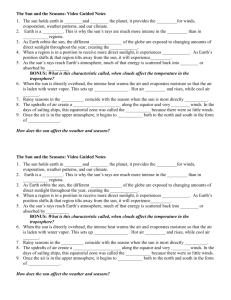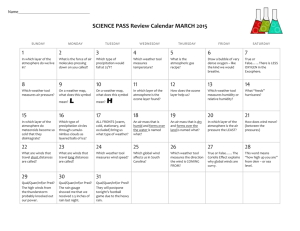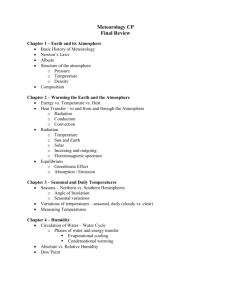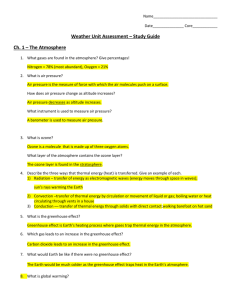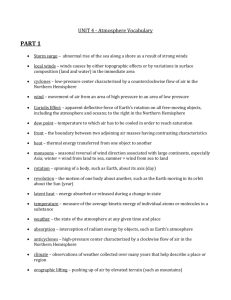Ch. 24.1-24.3 Study Guide
advertisement
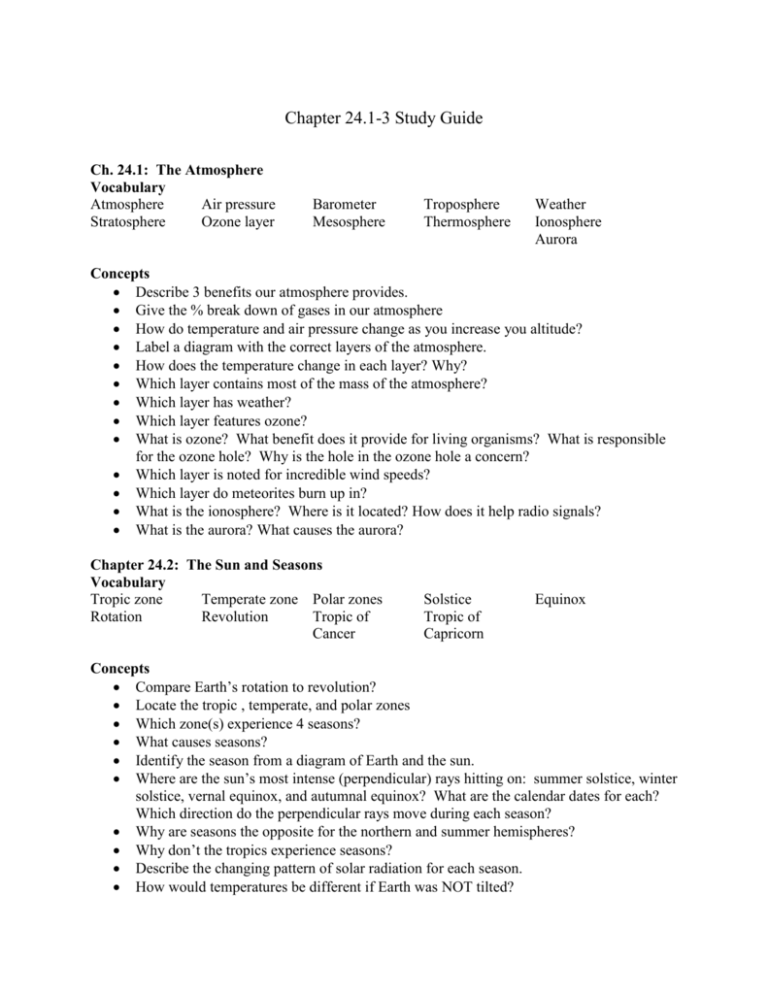
Chapter 24.1-3 Study Guide Ch. 24.1: The Atmosphere Vocabulary Atmosphere Air pressure Stratosphere Ozone layer Barometer Mesosphere Troposphere Thermosphere Weather Ionosphere Aurora Concepts Describe 3 benefits our atmosphere provides. Give the % break down of gases in our atmosphere How do temperature and air pressure change as you increase you altitude? Label a diagram with the correct layers of the atmosphere. How does the temperature change in each layer? Why? Which layer contains most of the mass of the atmosphere? Which layer has weather? Which layer features ozone? What is ozone? What benefit does it provide for living organisms? What is responsible for the ozone hole? Why is the hole in the ozone hole a concern? Which layer is noted for incredible wind speeds? Which layer do meteorites burn up in? What is the ionosphere? Where is it located? How does it help radio signals? What is the aurora? What causes the aurora? Chapter 24.2: The Sun and Seasons Vocabulary Tropic zone Temperate zone Polar zones Rotation Revolution Tropic of Cancer Solstice Tropic of Capricorn Equinox Concepts Compare Earth’s rotation to revolution? Locate the tropic , temperate, and polar zones Which zone(s) experience 4 seasons? What causes seasons? Identify the season from a diagram of Earth and the sun. Where are the sun’s most intense (perpendicular) rays hitting on: summer solstice, winter solstice, vernal equinox, and autumnal equinox? What are the calendar dates for each? Which direction do the perpendicular rays move during each season? Why are seasons the opposite for the northern and summer hemispheres? Why don’t the tropics experience seasons? Describe the changing pattern of solar radiation for each season. How would temperatures be different if Earth was NOT tilted? Chapter 24.3: Earth’s Energy Budget & Winds Vocabulary Radiation Albedo Air Pressure Conduction Greenhouse Gases Wind Convection Feedback Loop Monsoon wind Global winds Jet stream Coriolis Effect Concepts Earth’s Energy Budget Identify energy INPUTS in Earth’s energy budget. What wavelengths are absorbed by Earth? What % of energy from the sun gets REFLECTED back to space? What surfaces cause more solar energy to be reflected and Earth to cool? How can changing surfaces (and albedo) trigger a global warming or cooling episode? Identify energy OUTPUTS in Earth’s energy budget. What wavelength is radiated from Earth to space? How do greenhouse gases affect Earth’s energy output? How does this affect climate? Give 3 examples of a greenhouse gas. Heating Up the Atmosphere Identify the 3 ways that heat is distributed in the atmosphere. Give examples of each. o Radiation; Conduction; Convection Contrast properties of warm and cool air in terms of: o Density, Pressure, Kinetic Energy, Room for moisture, Rising/Sinking Wind Predict the direction of wind based on temperature differences. Compare a landbreeze to a seabreeze Explain WHY winds switch directions from day to night at the beach or during summer and winter for monsoon winds. Explain why monsoon winds reverse directions in summer and winter. How does this affect the amount of rain? Label global winds. What is the coriolis effect and how does it influence global winds? How do global winds in northern and southern hemisphere compare? Map out global convection cells. Where is air rising? Sinking? For the equator, 30 degrees, 60 degrees, and 90 degrees identify: o High or Low pressure o Rising or sinking air o Wet or dry What is the jet stream? How does it influence our weather?


